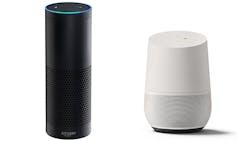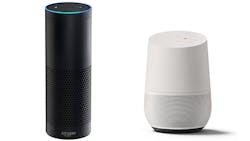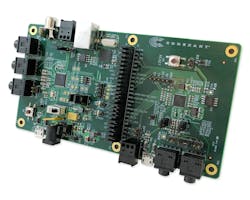Products that integrated with Amazon’s Echo/Alexa, Google’s Home (Fig. 1), and others like Apple’s Siri and Microsoft Cortana were out in force at the recent 2017 Consumer Electronics Show. Alexa is Amazon’s recognition and command processing software, while Echo is the hardware platform. These systems employ artificial intelligence (AI) and voice recognition to provide human-like interaction with people. They do so by always listening for commands they can respond to, from playing a particular song to ordering another box of diapers. They can also look up information like nearby restaurants.
These platforms require the cloud to do the heavy lifting for voice recognition and analysis, as well as fulfilling many of the actions initiated by voice commands. For example, changing the temperature of a local thermostat is an example of how Internet-of-Things (IoT) devices can be controlled by these systems. Integration with these platforms is relatively straightforward in terms of registering devices and commands. Things get a bit more difficult when trying to replicate platforms like Amazon Echo or Google Home since this requires a robust voice-capture platform.
One of the platforms available for Amazon’s Alexa system is the Conexant AudioSmart 2-Mic Development Kit for Amazon AVS (Fig. 2). It is based on Conexant’s AudioSmart CX20921 Voice Input Processor and it can be attached to a host system like the popular Raspberry Pi. The Proprietary Smart Source Pickup (SSP) system isolates voice and cancels noise from all directions. The platform is designed to recognize the command prefix even when loud music or audio playback is occurring.
Conexant was also showing a four-microphone system that provides directional voice capture. This would allow identification of the position of voice users.
Amazon appears to have an edge, more from being first and having a massive store available for orders. IoT devices from thermostats to electric cycles and charging systems had links to platforms like Alexa.
IoT devices typically link to only one of these platforms, although some tie into open IoT environments like Google Nest. That does mean customers will have to pick compatible IoT devices once they choose a platform like Google Home or Amazon Echo. Customers will also have to decide if having a system continually upload audio from their home or office to the cloud. In theory, this information will not be recorded, but analyzed for commands and then discarded.
The systems employ cutting-edge voice recognition and AI and will continue to improve, since the bulk of the analysis will be done in the cloud. Security and privacy issues will continue to be a point of discussion, and should be a consideration when employing these systems, although these are rarely discussed in their advertising. Still, adoption of these systems is on the rise, as are the IoT peripherals that can be controlled by them using voice commands or other, possibly less-intentional uses.
About the Author
William G. Wong
Senior Content Director - Electronic Design and Microwaves & RF
I am Editor of Electronic Design focusing on embedded, software, and systems. As Senior Content Director, I also manage Microwaves & RF and I work with a great team of editors to provide engineers, programmers, developers and technical managers with interesting and useful articles and videos on a regular basis. Check out our free newsletters to see the latest content.
You can send press releases for new products for possible coverage on the website. I am also interested in receiving contributed articles for publishing on our website. Use our template and send to me along with a signed release form.
Check out my blog, AltEmbedded on Electronic Design, as well as his latest articles on this site that are listed below.
You can visit my social media via these links:
- AltEmbedded on Electronic Design
- Bill Wong on Facebook
- @AltEmbedded on Twitter
- Bill Wong on LinkedIn
I earned a Bachelor of Electrical Engineering at the Georgia Institute of Technology and a Masters in Computer Science from Rutgers University. I still do a bit of programming using everything from C and C++ to Rust and Ada/SPARK. I do a bit of PHP programming for Drupal websites. I have posted a few Drupal modules.
I still get a hand on software and electronic hardware. Some of this can be found on our Kit Close-Up video series. You can also see me on many of our TechXchange Talk videos. I am interested in a range of projects from robotics to artificial intelligence.




